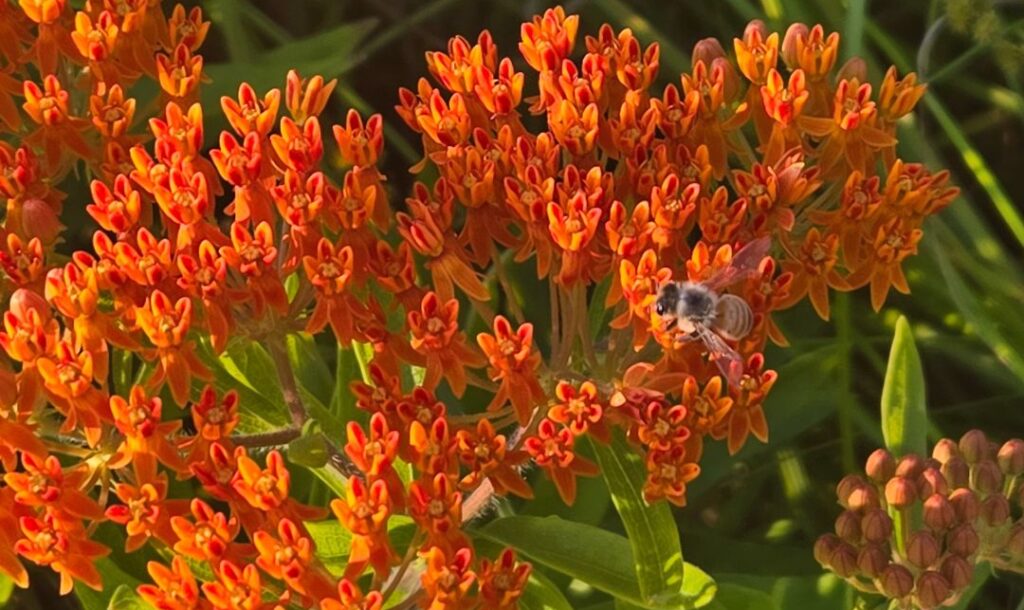Late winter is the time we may start dreaming about the color green, about flowers, imagining new vistas as we look out our windows or walk around our frozen yard. This is a wonderful time to explore a fresh outlook on our little piece of earth.
As new life emerges from dormancy, we may ask ourselves, “What is the purpose of my yard?” There are many possible answers: enjoying beauty and colorful flowers, conforming to the neighborhood, impressing neighbors and friends, providing pollinator habitat, creating a safe space for the kids to play, or helping to save our Rouge River and our planet.
Almost all of these goals can be accomplished in a way that helps save our planet and our Rouge River. Unfortunately, “to save our planet” has not been the driving force behind the horticulture industry. Ever since the front yard married the industrial revolution, the design template has been pristine, monoculture lawns, cookie-cutter landscapes, and chemical maintenance. As it turns out, these three very common components of home landscaping contribute to human illness, species extinction, and our climate crisis.
“The domestic front lawn is a typically American landscape feature. …The first attempts at lawns in America were made by wealthy landowners in the late eighteenth century, people who learned of the new English landscape fashion through books, English indentured gardeners, and travel.”
The Lawn: A History of an American Obsession
by Virginia Scott Jenkins
“In the past, we have asked one thing of our gardens: that they be pretty. Now they have to support life, sequester carbon, feed pollinators and manage water.”
by Doug Tallamy
author and co-founder of Homegrown National Parks.
The good news is that, with the information below and a little persistence, you can take steps in your outdoor spaces in 2025 to meet these ecological goals, thereby benefiting your Rouge River. The bonus is that these actions can also bring more beauty, vitality, and joy into your outdoor life this spring. And you don’t have to overhaul the whole yard, nor eliminate the entire lawn!
Maintain your lawn and landscape beautifully using organic methods.
This reduces the inevitable runoff into our watershed of the salt-based, high-nitrogen, water-soluble synthetic fertilizers, not to mention insecticides and herbicides. Organic methods are safer for pollinators and other beneficial insects (your allies), along with the microbial life in the soil. A soil that is rich with a healthy microbiome is also better able to absorb rainfall, reducing stormwater runoff.
Please also consider allowing benign “weeds” such as clover in your yard.
For the do-it-yourselfers, one product example is the granular Espoma brand Organic Lawn Food. For those who prefer to outsource, finding a truly organic lawn care service in this area is a challenge. Ask questions and ask for the ingredients list of any products recommended. (Spoiler alert: Milorganite is NOT organic. It is made from treated sewer sludge from Milwaukee).
Plant just one native plant
Plant just one native plant, or a whole garden! Even one native plant provides an ecosystem for beneficial insects. Native plants also benefit our River because their roots are deeper than any lawn or non-native landscape plant. Deep roots absorb more rainwater, reducing the volume of water entering our storm sewers. This reduces potential flooding and pollution entering our delicate waterways.
Have a landscape plant that is underperforming? Replace it with a native! Did you just find out that one of your existing plants is an “exotic invasive?” (Exotic invasives are non-native plants that turn into weeds, spreading into surrounding landscapes. One example is Japanese Barberry – Berberis thunbergii). Replace it with a native! Do you have an area of lawn that always looks awful? Find native plants that thrive in those conditions. (Wet or dry? Sun or shade? Clay or sandy soil?) Then, create an island garden there. There are so many beautiful native flowers, ornamental grasses, shrubs, and trees to choose from. Some natives even grow well in containers.
Plant just one native plant
Plant one native tree, if you have space for it. Doug Tallamy lists oak trees as keystone species, “the most productive native plants to support the most productive species.” Two examples that are native to our region are Red Oak (Quercus rubra) and White Oak (Quercus alba).
If you choose one or all three of these projects this spring, you will be rewarded with more beauty in your yard, and the knowledge that you have taken solid, positive action for your hometown river. Enjoy!
Categories
-
 BlogRead the latest blog posts from your FOTR team.
BlogRead the latest blog posts from your FOTR team.
